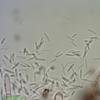
07-01-2026 10:24
 Danny Newman
Danny Newman
Pezicula sp. on indet. hardwood Appalachian Highl

07-01-2026 22:22
 Danny Newman
Danny Newman
Tatraea sp. on indet. hardwood The Swag, Great Sm

07-01-2026 17:29
 Marc Detollenaere
Marc Detollenaere
Dear Forum,On a barkless Populus I found some smal

10-11-2021 17:33
 Riet van Oosten
Riet van Oosten
Add-on topic http://www.ascofrance.com/forum/7059

07-01-2026 10:05
 Danny Newman
Danny Newman
cf. Chaetospermum on XylariaCosby Campground, Grea

02-01-2026 17:43
MARICEL PATINOHi there, although I couldn't see the fruitbody, I

04-01-2026 17:45
 Stephen Martin Mifsud
Stephen Martin Mifsud
I was happy to find these orange asmocyetes which
The apo is short stipitate with scattered marginal hairs 54-76 × 6,0-8,2 µm, walls on avg. 0,7 µm thick, ±capitate. Asci probably without croziers, 39-45 × 3.0-3.7 µm, IKI bb, 8-spored. Ascospores (6.5) 6.7-8.9 (10.4) × (1.5) 1.6-1.97 (2.0) µm, oil 0. Paraphyses lanceolate, 62-70 × 3.4-3.5 µm.
In the litteratre I have found two (potentially synonymous) taxa on Carex. Karsten's Trichopezizella nidulus var. hystricula was also on C. acuta collected not far away. Hains (1974) gives the spore size as (9-)10-14(-15) X 2-3 µm and hairs to 130 µm.
Trichopezizella badiella, likwise Karsten's, was collected on Bolboschoenus maritimus. Both original collections were immature but the name has, nevertheless, been used later for a species with spores 8-10x2 µm and hairs to 130x6 µm, also on Carex.
My fungus has somewhat smaller spores and shorter hairs. I am a bit confused - what should I call this fungus, T. cf. badiella perhaps? Any experience of this complex, someone?








